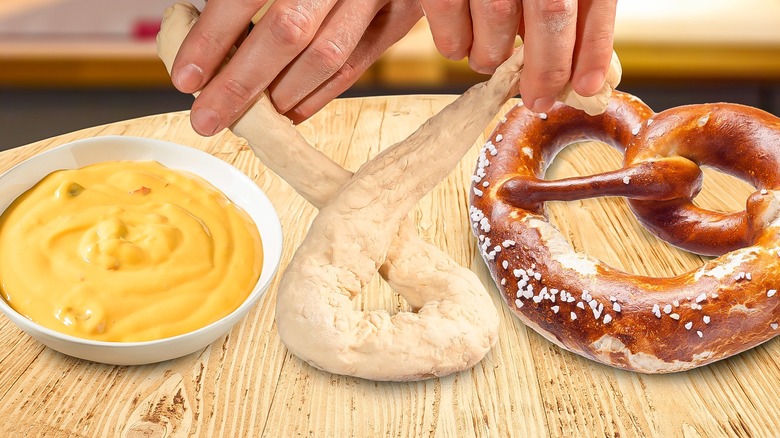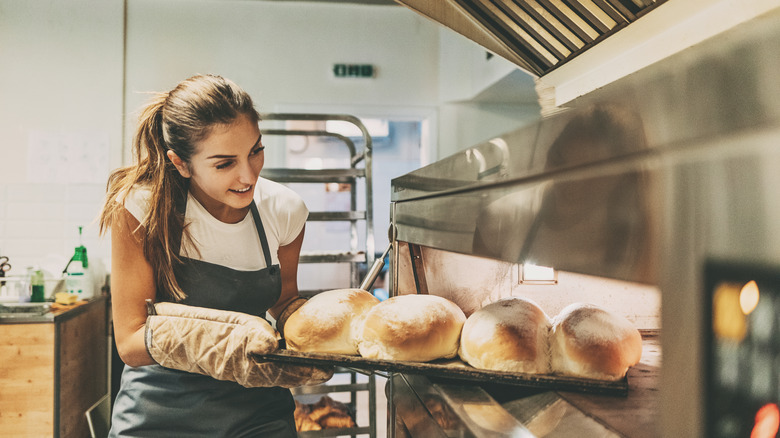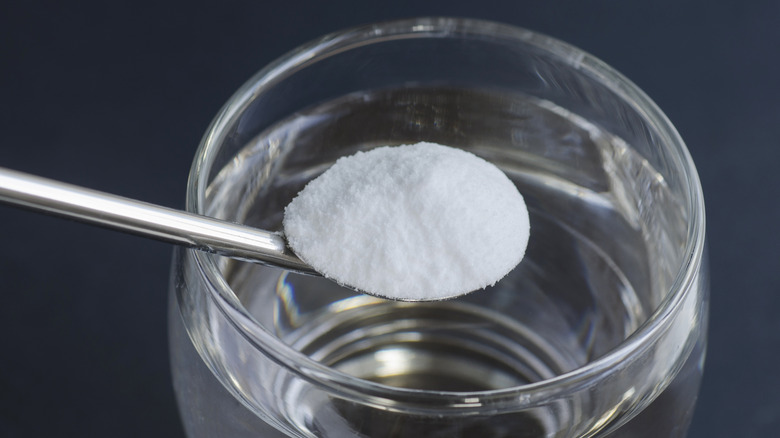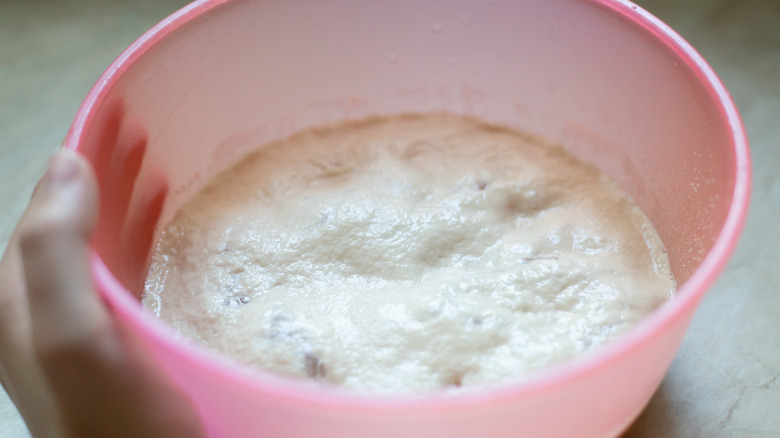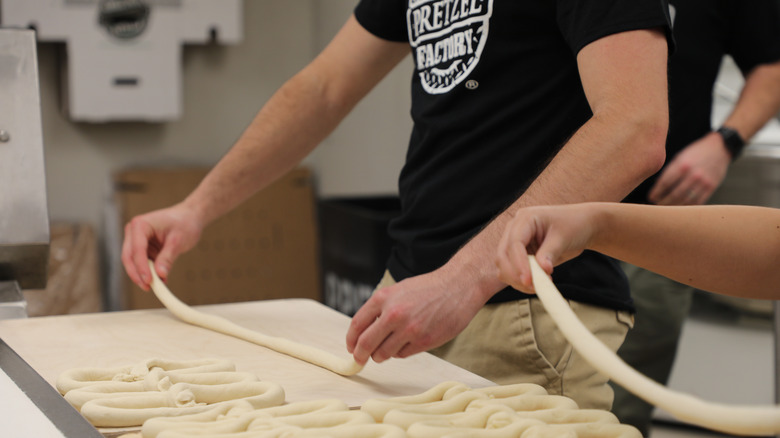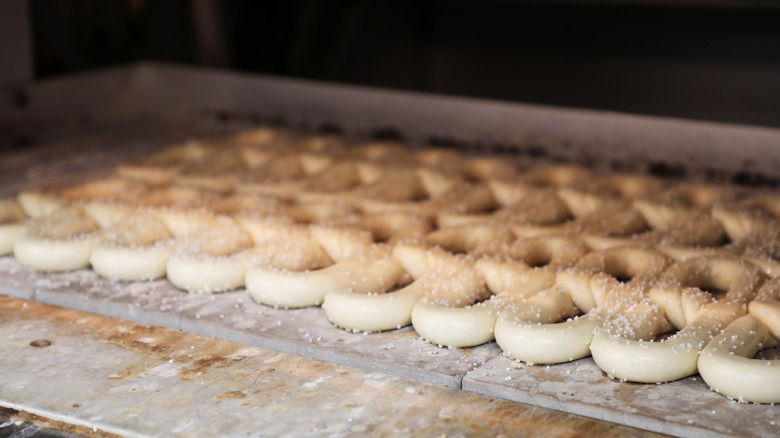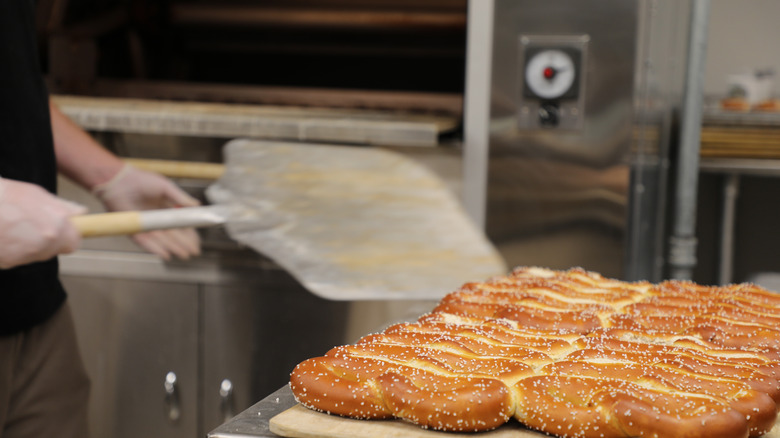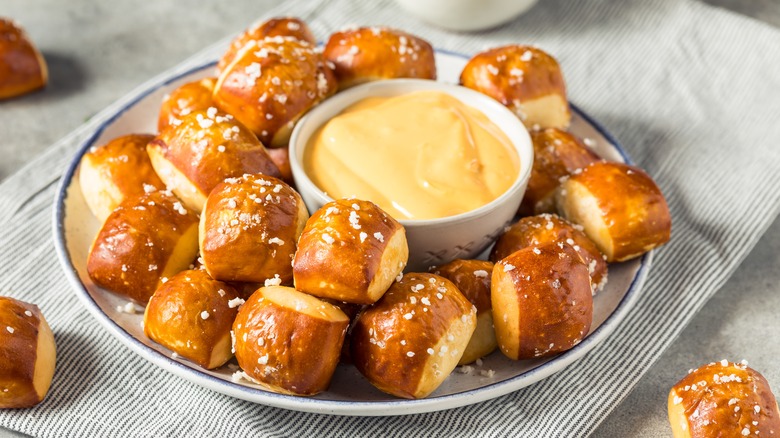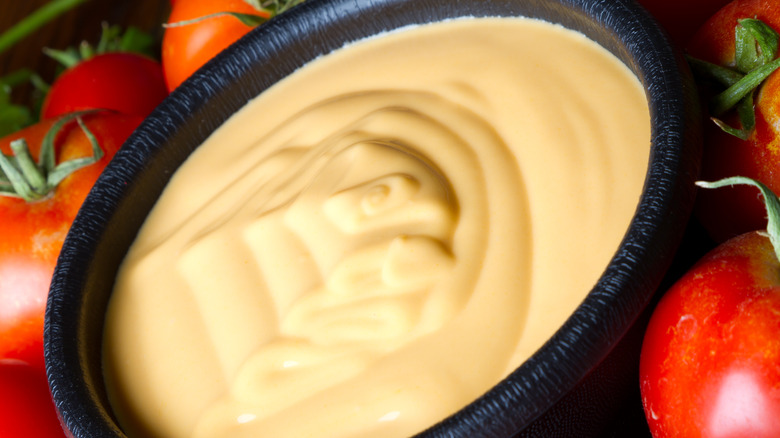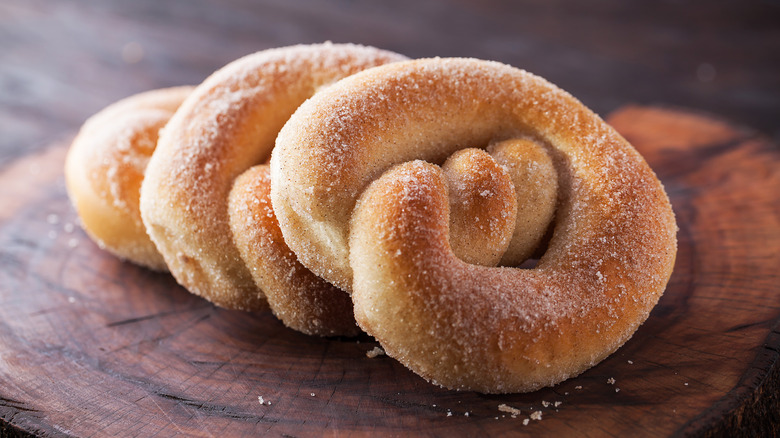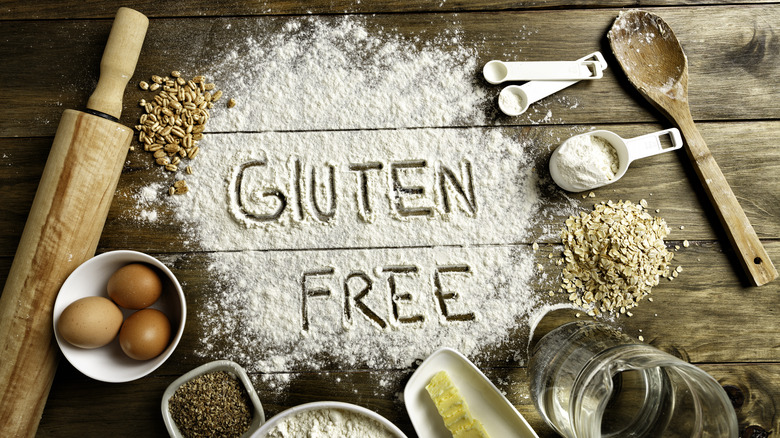10 Tips For Making Glorious Soft Pretzels From Scratch
Taking a chilly winter afternoon and dedicating it to making homemade soft pretzels sounds like the perfect cold-weather activity to us. Of course, you've heard of plenty of folks making homemade sourdough bread, baking sugar cookies, and other iconic homemade baked goods, but have you considered making homemade soft pretzels? You should, but not without taking a few things into consideration first.
Pennsylvania is host to the "Pretzel Capitol of the World," the town of Reading, so when wanting to learn more about making glorious soft pretzels from scratch, it only made sense to speak to someone at a nearby company that lives and breathes soft pretzels: The Philly Pretzel Factory. We spoke to Kristina Eckart, Research and Development Manager at Philly Pretzel Factory corporate, about all things homemade soft pretzels. From the best ways to activate your yeast to creative flavor combinations, here are tips you need before embarking on a soft pretzel-making journey of your own.
Set your bread bakers to go
If you have dabbled in the bread-baking world before, you should be pretty much set to go with the equipment and ingredients needed for baking soft pretzels. "Bread, pretzels, they don't have a lot of ingredients," Kristina Eckart noted. What you'll need to get this process started is water, baking soda, a stand mixer with a bread attachment, active dry yeast, sugar, salt, all-purpose flour (though more on that in a moment), butter, and your seasoning toppings.
Though most recipes you'll find recommend using all-purpose flour (and there's nothing wrong with it), Eckart thinks you can upgrade things a notch. "I feel like a lot of times I see recipes for bread or pretzels that say to use all-purpose flour, but I feel like sometimes bread flour could give you a better texture." Bread flour actually has a higher protein content, making it the best type of flour you can bake with for anything, including soft pretzels. More protein means more gluten developed, which leads to a higher, fluffier rise on your bread item. Who wouldn't want that?
Make the water more alkaline
Every step in any bread-baking endeavor is vital to having an ideal end product that is soft and risen. "I think probably one of the more important parts of making pretzels is, like when you make bagels, you're boiling water, and you are adding (with pretzels) something to make the water more alkaline," Kristina Eckart stated. If you're unfamiliar, all water has a pH level on the acidic to alkaline scale, with fresh water typically existing right in the middle of that scale. Because it's usually pretty neutral, you have to add an element to your boiling water to make it more alkaline so that your soft pretzels get that nice crust on the outside that you know and love.
"You could use baking soda," Eckart noted. According to her, some commercial operations do use baking soda, but Eckart reports that Philly Pretzel Company uses baker's lye. Per Eckaet, it's "a more traditional — I would say European — way of making pretzels." Another benefit of making your boiling water more alkaline with baker's lye is that the soft pretzels will come out super shiny, just like they would if you got them from a professional bakery.
Activate the yeast carefully
While we discussed in the last slide that every step in the bread-baking process is important (and it is), we simply have to stress the extra importance of activating the yeast carefully and correctly. "When you are making a bread or pretzel at home, you're using yeast, whether it be dry or active yeast that needs to be refrigerated," Kristina Eckart added. In order to activate any kind of yeast, you need to put it in warm water with something sweet for the yeast to feed on — like sugar or honey. When talking about most bread recipes, Eckart notes, "It always says, oh, put it in warm water and just allow it to kind of start activating and it'll get foamy." Obviously, baking bread is all about precision, down to the temperature of the water you're activating your yeast in.
Eckart notes that the water should be between 110 F and 115 F and that if your yeast mixture hasn't become frothy within 10 minutes of it sitting in the warm water and sugar, you need to start over. She also adds that for her, the ideal thing for the yeast to munch on is honey because it's easier for the yeast to digest, and you'll get things going a bit quicker.
Twist the pretzels in unique shapes
Now comes the fun part that any friends, family, or kids can have a blast participating in — twisting the pretzels into unique shapes. You can obviously go for the classic, standard soft pretzel shape that looks like your legs look when sitting criss-cross apple sauce. However, there are so, so many shapes out there you can explore.
Are you making this a date night activity? Then why not try making some heart-shaped soft pretzels? Do you prefer the nuggets (or rivets, as they are called at the Philly Pretzel Factory) to the bigger full-sized pretzels? Then, according to Kristina Eckart, they are easy to make. Just stretch and roll out the dough into long, even strips, then cut even-sized nugget pretzel sizes. You can also always follow suit with the pretzel capital of the world and make them Philly style, which looks like a paper clip. The options are limitless, so only your imagination can stop you.
Don't stretch one area way thinner than another
While stretching your dough into creative shapes is one of the most fun points in the baking experience, you also have to be mindful of one crucial thing: Not stretching one area way thinner than another. You are embarking on this journey in order to have a soft pretzel end product — not a hard pretzel end product. When you make one area of your soft pretzel way thinner than another, it's obviously going to be tougher and crunchier than the other areas, and it won't cook evenly through. You want a nice even bake throughout the whole pretzel, no matter what shape you've turned it into.
"Some shapes aren't as conducive to making a really good-tasting pretzel," Kristina Eckart noted. "When you layer a lot of dough into one area, and then maybe not another area, it bakes faster, because perhaps it's thinner." So while you should totally encourage everyone to make the shapes they want, just monitor the process and make sure every section is equal so that nobody is disappointed in the end when one part comes out burnt because it was thinner.
You can flavor with more than just salt
Pretty much every soft pretzel recipe you'll come across has you adding some chunky flaky salt on top of your pretzels. And for the record, there's nothing wrong with that. In fact, we love the classic version of soft pretzels. But when you're making them at home, now is the time to put your own spin on things and get funky with them. Instead of just flaky salt, you can try any seasoning you want out there. Go a little bit rogue with pink Himalayan salt, or do a salt and pepper pretzel. Try out some smoky flavors like paprika, or even put some garlic powder on there.
Kristina Eckart suggested potentially the most fun seasoning idea of all, "They're just like with bagels," Eckart said. "There are people that do everything bagels. I mean, we've done everything pretzels." Based on this principle alone, any type of bagel you enjoy, you can turn into a soft pretzel. "When we bake them in our store, in the office, it's like the whole office is definitely making everything pretzels because you can smell the garlic, and it's a really nice smell."
Pair your flavors and dips creatively
But don't just stop there at the seasoning level. We think there is a whole world of options out there for your soft pretzel flavors, and one of the best places to start is with flavor combinations you're already a fan of. For instance, you can make an Italian-inspired soft pretzel, add Italian seasoning to the pretzel, and then pair it with a marinara dipping sauce on the side. You can go Greek with it and add a little bit of dill seasoning to your soft pretzel, then dip it in a creamy tzatziki sauce.
You can truly come up with any flavor pairings you like using whatever flavor inspiration you choose, from truffle to hot chile peppers to garlic bread to olives, the choice is yours for the taking. We think seasoning a few of your pretzels with different seasonings, and then pairing them with complementary dips would make a fun party appetizer that switches things up for your guests.
Top tips for cheese dip
Don't worry, we didn't forget about one of the most popular dips for soft pretzels — cheese dip. While mustard is a hot contender rivaling first place, we figured we'd give a few top tips for making your own cheese dip for soft pretzels, since it's bound to be one of the first things you try to pair them with when making them. "I'm partial to just a plain, American cheese dip, or like a Cooper sharp," Kristina Eckart noted. "I feel like it just gets so creamy and hangs on the pretzel so nicely."
Something else Eckart made a note of, though, is that even when you choose the sharpest cheese you've ever tasted, it will lose at least some of (if not a lot of) its bite when cooked down into the liquid sauce form. So if you're thinking of using your favorite, hard-to-find, bitter, sharp block of cheese as your dip, maybe think twice before doing so.
Sweeten things up
All of those savory options are quite delicious, and our mouths are watering just thinking about them, but sometimes the best way to serve up your soft pretzels is actually sweet, not savory. Everyone knows that sweet and salty go together, so you could start with a classic Philly Pretzel Factory favorite (and our personal kryptonite), the flaky salt-soft pretzels dipped in the cinnamon sugar dipping sauce. We've seen real-life skeptics of this combo be turned into die-hard fans of the cinnamon sugar dip, so we're here to convert all of you today. No, but actually this dip is pretty easy to make, and it's just one sweet option for your soft pretzels. You can play with your own ratios of things to make the dip to your liking, but (we hypothesize — this is a top-secret recipe) that it's probably just cinnamon, powdered sugar, butter, and maybe a sweetener like vanilla extract.
If cinnamon isn't your vibe, there are many other ways to amp up the sweetness factor of your soft pretzels. Follow Philly Pretzel Factory's lead and try a brownie batter-inspired dip, or do strawberries and cream, cannoli, mint chocolate chip, or cookies and cream. The sweet dip options are truly endless, as are the seasonings you could add to the pretzels themselves, like cinnamon sugar or just plain sugar.
Gluten-free soft pretzels are possible
If you've been reading this article glum about the fact you're gluten-free and can't participate in all the homemade soft pretzel fun, don't despair. It is completely possible to make gluten-free soft pretzels, just like you know it's possible to make delicious gluten-free bread. Kristina Eckart noted that, like any gluten-free dough, it gets a bit stickier and harder to manipulate than regular dough because of the lack of gluten. So if you're working with gluten-free soft pretzel dough, perhaps stick with a simpler shaped pretzel, or just be very patient with yourself to achieve that complicated end result you're looking for.
To make a gluten-free dough, you'd simply swap out the bread flour for a gluten-free iteration, like rice flour or tapioca flour. Plus, since you're making these at home, you have complete control over keeping your environment gluten-free, and you won't have to worry about potential cross-contamination from a bakery you're unsure about.
